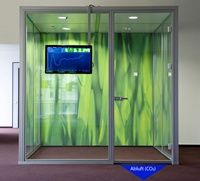Intelligent door-sealing system lets in fresh air in airtight rooms
21 Jun 2013
For a long time, when heat insulation was en vogue, no one was really concerned about the poor quality of indoor air, even though it is well known that excess CO2 hampers concentration and indusces drowsiness.
 |
| On display at the Fraunhofer inHaus-Center in Duisburg beginning in June: the door seal system developed by IMS. (© Fraunhofer IMS) |
When the air in the conference rooms becomes stuffy and stale, increased levels of carbon dioxide (CO2) lead to tiredness and imapair concentration.
Now, researchers have come up with an intelligent door-seal system that involves airing the room out. Or else rely on the intelligent door seal system that has now been developed by researchers at the Fraunhofer Institute for Microelectronic Circuits and Systems IMS in cooperation with the Athmer Company. Users of the system not only spare themselves the effort of regular airing: the door seal is also cold air's worst enemy, insulating to provide a perfect indoor climate.
Indoor concentrations of CO2 are still a problem, particularly in newer buildings. ''Modern buildings are becoming increasingly airtight,'' according to Hans-Jürgen Schliepkorte, group manager at Fraunhofer IMS in Duisburg.
On the one hand, better windows and construction materials provide effective insulation - an issue that was long a major concern. But air quality was overlooked in the process. ''In many cases, the supply of fresh air still comes through an open window,'' Schliepkorte points out. ''This has consequences for the energy efficiency.''
Sensor measures CO2 concentration in the air
The electronically controlled door seal developed by IMS engineers opens or closes based on the CO2 concentration in a room. A CO2 sensor records concentrations in the air. If this value exceeds a certain threshold, a tiny motor moves a spring to open the door seal at the bottom of the door leaf.
The seal raises to permit an exchange of air inside the room. At the same time, the system uses building based measurement and control technology to activate the ventilation system to extract stale air from the room.
''Our standard is based on the Pettenkofer value of 1000 ppm (parts per million),'' Schliepkorte explains. It was Max von Pettenkofer who investigated indoor air quality in the middle of the previous century and identified the CO2 value that, if met or exceeded, makes people begin to feel unwell indoors. Today's rules and guidelines based on DIN for the workplace set 1500 ppm as the upper limit and recommend a CO2 concentration of 1000 ppm. ''We can achieve this with the aid of the intelligent door seal – without having to open doors or windows,'' Schliepkorte observes.
The door seal system is electronically coupled with building measurement and control systems. If a ventilation system or for that matter a heat recovery system has been installed, they can additionally be activated based on indoor CO2 concentrations and temperatures.
''The system always calculates the best compromise between good indoor air and optimal utilization of energy efficiency,'' Schliepkorte says. Beginning in June of this year, it will be in use in the Fraunhofer inHaus-Center in Duisburg, an innovation workshop for application oriented and market based research for systems in rooms and buildings.
Indeed, Fraunhofer researchers have already set their sights on further applications: in the future, the door seal may well also help regulate humidity in residential and commercial buildings. This may soon make mold in the home and dry eyes in the office a thing of the past.